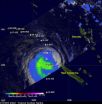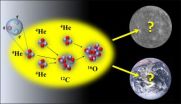More accurate, sensitive DNA test allows early identification of fungus causing WNS
2013-03-14
(Press-News.org) MADISON, Wis., March 13, 2013 – Even after researchers studying White Nose Syndrome (WNS) established that a fungus called Geomyces destructans is at the heart of the devastating disease, detecting it depended largely on finding dead or dying bats.
This month, the journal Mycologia will publish research by a team of U.S. Forest Service scientists and partners identifying additional species of Geomyces and describing development of a highly sensitive DNA-based technique for early identification of Geomyces destructans on bats as well as in soils and on cave walls.
"The significance of the Forest Service's recent research will have an immediate and direct benefit to WNS response at a national scale," according to Katie Gillies, imperiled species coordinator at Bat Conservation International. "This will allow managers to sample soil and substrates to test for the presence of Geomyces destructans, freeing up limited surveillance funds and time. Additionally, this opens the door to examine the use of gene silencing as a control mechanism for this devastating fungus. Research like this, that directly benefits resource managers and guides us to controlling this fungus, is critically needed."
Daniel Lindner, a research plant pathologist with the Forest Service's Northern Research Station, led research that identified 35 species of Geomyces, more than doubling the number of known species. Lindner and partners used that research to develop a DNA-based detection test for Geomyces destructans that is much more sensitive and accurate than previous tests. Forest Service scientists collaborated with the U.S. Geological Survey and the University of Wisconsin for both studies.
"At best, only 5 to10 percent of fungal species on earth have been named and scientifically described," Lindner said. "Developing a specific test for this fungus was difficult because we found that every sample from bats and caves contained a huge diversity of unidentified, unnamed fungi, and these were interfering with detection."
White Nose Syndrome was first identified in Upstate New York in 2006. Since then it has spread to caves throughout the East Coast and killed millions of bats, and it continues to spread.
"White Nose Syndrome is arguably the most devastating wildlife disease we've faced," said Michael T. Rains, Director of the Forest Service's Northern Research Station. "Forest Service scientists are conducting research to halt this disease and save bats, which are so important to agriculture and forest ecosystems."
Scientists identified Geomyces destructans as the cause of WNS in 2012. Conclusively identifying the fungus either on a bat or in soil has been difficult and time consuming because a variety of closely related Geomyces species found where bats hibernate have the potential to cause false positives using previous DNA testing. Previous tests also lacked sensitivity, making it possible to miss the fungus in some samples. The new test is 100-times more sensitive than previous tests and can detect a single spore of the fungus.
###
"Bat white-nose syndrome: A real-time TaqMan polymerase chain reaction test targeting the intergenic spacer region of Geomyces destructans" is available at: http://www.nrs.fs.fed.us/pubs/42974 "A culture-based survey of fungi in soil from bat hibernacula in the eastern United States and its implications for detection of Geomyces destructans, the causal agent of bat white-nose syndrome" is available at: http://www.nrs.fs.fed.us/pubs/42973
Co-authors on the study documenting development of the new DNA-based technique for testing for Geomyces destructans included David Blehert and Laura Muller of the U.S. Geological Survey's National Wildlife Health Center, Jeffrey Lorch of the University of Wisconsin, Andrea Gargas of Symbiology LLC, and Michael O'Conner of the Wisconsin Veterinary Diagnostics Lab. Co-authors on the paper examining fungi in hibernacula included Blehert, Muller, Lorch and Gargas.
The mission of the U.S. Forest Service is to sustain the health, diversity, and productivity of the nation's forests and grasslands to meet the needs of present and future generations. The agency has either a direct or indirect role in stewardship of about 80 percent of our nation's forests; 850 million acres including 100 million acres of urban forests where most Americans live. The mission of the Forest Service's Northern Research Station is to improve people's lives and help sustain the natural resources in the Northeast and Midwest through leading-edge science and effective information delivery.
ELSE PRESS RELEASES FROM THIS DATE:
Symbols, such as traffic lights, on menus effective in educating diners
2013-03-14
CHAMPAIGN, Ill. — A little-noticed provision of the Affordable Care Act requires all chain restaurants and retail food establishments with 20 or more locations to list calorie counts on their menus. But according to research co-written by a University of Illinois agricultural economist, numeric calorie labels might not be the most effective way to influence patrons to select "healthier" (often interpreted as lower-calorie) items.
Brenna Ellison, a professor of agricultural and consumer economics, says placing a symbolic label in addition to the numeric calorie information ...
NASA sees large decrease in Cyclone Sandra's rainfall intensity
2013-03-14
NASA's Tropical Rainfall Measuring Mission satellite, also known as TRMM, flew over Cyclone Sandra twice in one day and noticed a large decrease in rainfall intensity over a nine hour period.
On March 11, 2013, NASA's TRMM satellite twice flew above weakening tropical cyclone Sandra as it was passing to the west of New Caledonia in the southern Pacific Ocean. TRMM's Precipitation Radar (PR) had a very good view of Sandra as it passed directly above the tropical cyclone on March 11 at 1312 UTC (9:12 a.m. EST). TRMM PR measured rainfall at the extreme rate of over 206 mm ...
Dwelling on stressful events can increase inflammation in the body, study finds
2013-03-14
ATHENS, Ohio (March 13, 2013)—Dwelling on negative events can increase levels of inflammation in the body, a new Ohio University study finds.
Researchers discovered that when study participants were asked to ruminate on a stressful incident, their levels of C-reactive protein, a marker of tissue inflammation, rose. The study is the first time to directly measure this effect in the body.
"Much of the past work has looked at this in non-experimental designs. Researchers have asked people to report their tendency to ruminate, and then looked to see if it connected to physiological ...
Scientists discover novel chemical that controls cell behavior
2013-03-14
March 12, 2013 — Albuquerque, NM (UNM Cancer Center) — It's the spread of the original cancer tumor that kills most people. That's why cancer researchers vigorously search for drugs that can prevent metastases, the spread of cancer. The research team co-led by Angela Wandinger-Ness, PhD, and Larry Sklar, PhD, at the University of New Mexico Cancer Center has found a chemical compound that appears to control cell migration and adhesion, two important characteristics of metastatic cancer cells. The team recently published a paper describing how the first-in-class compound ...
Sun spits out 2 CMEs
2013-03-14
The sun recently erupted with two coronal mass ejections (CMEs). One began at 8:36 p.m. EDT on March 12, 2013 and is directed toward three NASA spacecraft, Spitzer, Kepler and Epoxi. There is, however, no particle radiation associated with this event, which is what would normally concern operators of interplanetary spacecraft since the particles can trip computer electronics on board. A second CME began at 6:54 a.m. EDT on March 13, 2013 and its flank may pass by Earth at a speed that does not typically have a significant impact at Earth.
Experimental NASA research models, ...
Vitamin D may lower blood pressure in African-Americans
2013-03-14
Boston – High blood pressure, a risk factor for heart attacks, heart failure and stroke, is 40 percent more common in African-Americans than in other American ethnic groups. In a new study from Brigham and Women's Hospital (BWH), along with the Dana-Farber Cancer Institute and Massachusetts General Hospital, researchers show that vitamin D supplementation may help African-Americans lower their blood pressure. The study publishes online in the March 13, 2013 edition of the American Heart Association journal Hypertension.
"This study may explain and help treat an important ...
US lifespans lags other high-income countries, tied to mortality rates under age 50
2013-03-14
Higher mortality rates among Americans younger than 50 are responsible for much of why life expectancy is lower in the United States than most of the world's most developed nations.
The research, by Jessica Ho, a University of Pennsylvania doctoral candidate in demography and sociology, found that excess mortality among Americans younger than 50 accounted for two-thirds of the gap in life expectancy at birth between American males and their counterparts and two-fifths between females and their counterparts in the comparison countries.
The study, "Mortality Under Age ...
Foundations of carbon-based life leave little room for error
2013-03-14
Life as we know it is based upon the elements of carbon and oxygen. Now a team of physicists, including one from North Carolina State University, is looking at the conditions necessary to the formation of those two elements in the universe. They've found that when it comes to supporting life, the universe leaves very little margin for error.
Both carbon and oxygen are produced when helium burns inside of giant red stars. Carbon-12, an essential element we're all made of, can only form when three alpha particles, or helium-4 nuclei, combine in a very specific way. The ...
UI study of Midwest finds increase in heavy rainfalls over 60 years
2013-03-14
Heavy rains have become more frequent in the upper Midwest over the past 60 years, according to a study from the University of Iowa. The trend appears to hold true even with the current drought plaguing the region, the study's main author says.
The fact that temperatures over the country's midsection are rising, too, may be more than coincidence.The hotter the surface temperature, which has been the trend in the Midwest and the rest of the world, the more water that can be absorbed by the atmosphere. And the more water available for precipitation means a greater chance ...
Video game 'exercise' for an hour a day may enhance certain cognitive skills
2013-03-14
Playing video games for an hour each day can improve subsequent performance on cognitive tasks that use similar mental processes to those involved in the game, according to research published March 13 in the open access journal PLOS ONE by Adam Chie-Ming Oei and Michael Donald Patterson of Nanyang Technological University, Singapore.
Non-gamer participants played five different games on their smartphones for an hour a day, five days of the week for one month. Each participant was assigned one game. Some played games like Bejeweled where participants matched three identical ...



